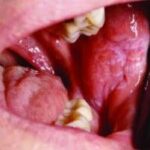Distinguishing between various skin lesions on the hands can be challenging, especially when conditions share similar locations. Gottron’s papules, a hallmark cutaneous manifestation of dermatomyositis, are often mistaken for other dermatologic conditions, notably knuckle pads. Accurate differential diagnosis is crucial for prompt and appropriate management. This article delves into the differential diagnosis of Gottron’s papules, primarily contrasting them with knuckle pads, while also considering other relevant conditions.
Understanding Gottron’s Papules
Gottron’s papules are characterized by erythematous to violaceous, flat-topped papules or plaques typically found symmetrically over the metacarpophalangeal (MCP) and interphalangeal joints (IP) on the dorsal aspect of the hands. They are a specific cutaneous finding in dermatomyositis, an autoimmune inflammatory myopathy. These lesions can sometimes exhibit scale, atrophy, or ulceration. While the location might overlap with other hand dermatoses, the clinical context of dermatomyositis, which may include muscle weakness, systemic symptoms, and specific autoantibodies, aids in diagnosis.
Knuckle Pads: Benign Mimics
Knuckle pads, also known as dorsal pads, are benign, circumscribed thickenings of the skin located over the dorsal aspects of the interphalangeal joints. They are often idiopathic but can be associated with repetitive trauma, friction, or certain systemic conditions like Dupuytren’s contracture. Clinically, knuckle pads present as smooth, firm, sometimes hyperkeratotic papules or nodules. Unlike Gottron’s papules, they are typically skin-colored to slightly erythematous and lack the violaceous hue and potential for atrophy seen in Gottron’s papules. The absence of systemic symptoms and muscle weakness further distinguishes knuckle pads from dermatomyositis-related Gottron’s papules.
Figure 1. Knuckle pads on the hand joints, showing their typical location and appearance.
Key Differentiating Features: Gottron’s Papules vs. Knuckle Pads
| Feature | Gottron’s Papules | Knuckle Pads |
|---|---|---|
| Appearance | Flat-topped papules/plaques, erythematous/violaceous | Smooth, firm papules/nodules, skin-colored/erythematous |
| Texture | May have scale, atrophy, ulceration | Smooth, may be hyperkeratotic |
| Underlying Condition | Dermatomyositis | Idiopathic, trauma, fibrosing conditions |
| Systemic Symptoms | Muscle weakness, fatigue, other systemic signs | Absent |
| Associated Signs | Gottron’s sign, heliotrope rash, shawl sign | May be associated with Dupuytren’s contracture |
| Palpation | Non-tender | Non-tender |
Figure 2. Close-up view of knuckle pads, highlighting their well-defined borders and hyperkeratotic surface.
Other Considerations in Differential Diagnosis
While knuckle pads are a primary differential for Gottron’s papules due to their shared location on the hand joints, other conditions should also be considered:
- Rheumatoid Nodules: These subcutaneous nodules can occur near joints in patients with rheumatoid arthritis. However, they are typically deeper, firmer, and may be associated with other signs of rheumatoid arthritis, such as joint inflammation and systemic symptoms.
- Granuloma Annulare: This chronic skin condition can present with кольцевидные papules, sometimes on the hands and fingers. However, granuloma annulare lesions are usually кольцевидные (ring-shaped) and lack the violaceous hue of Gottron’s papules.
- Warts (Verrucae): Viral warts can occur anywhere on the skin, including the hands. They are typically rough, exophytic papules, often with punctate black dots (thrombosed capillaries). Their appearance and texture are distinct from Gottron’s papules and knuckle pads.
- Scars and Keloids: A history of trauma or surgery might lead to scar formation over the joints. Scars and keloids are usually linear or irregular and lack the inflammatory appearance of Gottron’s papules.
- Psoriasis: Psoriatic plaques can affect the dorsal hands and joints, but they typically present with thick, silvery scales and are often associated with nail changes and other typical psoriatic lesions.
Diagnostic Approach
The differential diagnosis of Gottron’s papules begins with a thorough clinical examination, considering the morphology, distribution, and associated symptoms. A detailed patient history, including any muscle weakness, systemic symptoms, and family history of autoimmune diseases, is crucial.
If Gottron’s papules are suspected, further investigations to rule out dermatomyositis are warranted. These may include:
- Muscle enzyme testing: Creatine kinase (CK), aldolase, and other muscle enzymes are often elevated in dermatomyositis.
- Autoantibody testing: Myositis-specific antibodies (MSAs) and myositis-associated antibodies (MAAs) can aid in diagnosis and subtyping of dermatomyositis.
- Electromyography (EMG): To assess for myopathic changes.
- Muscle biopsy: In some cases, muscle biopsy may be necessary to confirm the diagnosis of dermatomyositis.
- Skin biopsy: A skin biopsy of the lesion can help differentiate Gottron’s papules from other dermatoses, although it is not always specific for dermatomyositis.
In cases where knuckle pads are suspected, the diagnosis is often clinical. However, if there is diagnostic uncertainty or suspicion of underlying systemic conditions, further evaluation may be considered to rule out associated diseases.
Conclusion
Accurate differentiation of Gottron’s papules from knuckle pads and other hand dermatoses is essential for appropriate patient management. While Gottron’s papules are a significant indicator of dermatomyositis requiring systemic evaluation and treatment, knuckle pads are typically benign. A careful clinical assessment, consideration of associated features, and appropriate investigations when needed are key to arriving at the correct diagnosis and ensuring optimal patient care.
